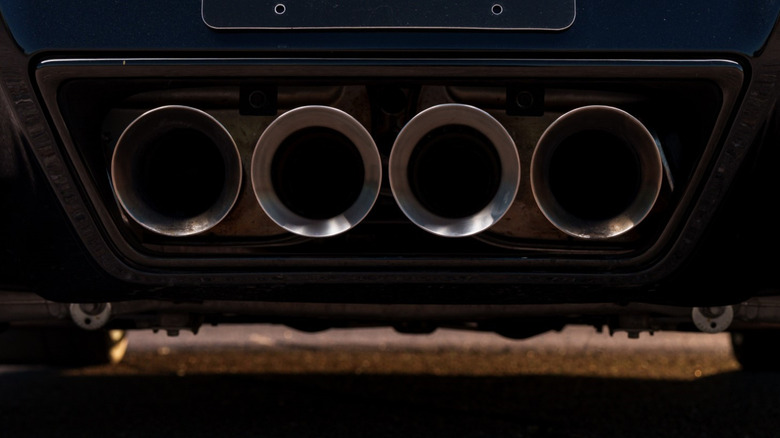Why Do Some Cars Have Four Exhaust Pipes? Here's What They're For
Four exhaust pipes sticking out the rear of a car might seem purely cosmetic, and in many cases, they are. But in others, especially in high-performance vehicles with over 1000 horsepower, quad exhausts have key mechanical functions. They can help the engine breathe better and run more efficiently.
High-performance sports cars produce a high volume of exhaust gases, and splitting those gases into four separate outlets helps them exit the system more easily, especially at high speeds or under heavy acceleration. This reduces strain on the engine since it doesn't have to work as hard against built-up pressure in the exhaust system. That buildup, known as backpressure, can slow the flow of waste gases and hinder performance if not managed properly.
Another significant factor in using multiple exhaust pipes is the sound they produce. A quad exhaust system can produce a louder, deeper, and more pronounced exhaust note, which enhances the driving experience. This is part of the "sound tuning" process, where manufacturers aim to make the car's sound as distinctive as its performance.
Of course, not every car with four pipes is designed for performance. Some are built that way just to mimic the look and seem more powerful than what's actually under the hood. For instance, the 2020 Ford Explorer ST employs a design where the visible quad exhaust tips are not directly connected to the exhaust system.
Instead, the actual exhaust gases are expelled through downward-facing outlets hidden beneath the vehicle, while the chrome tips solely serve a cosmetic purpose. To draw a contrast between such tips and an actual performing mechanism, it helps to look at how the system is designed.
How quad exhaust systems actually work
Although quad exhaust tips contribute to a car's visual and auditory appeal, they don't significantly impact the engine's performance in terms of horsepower or efficiency compared to other exhaust designs. Most of the performance benefits come from the internal components of the exhaust system, such as the diameter of the pipes and the overall exhaust flow, rather than the sheer number of pipes themselves.
However, there's an internal quad exhaust system in some high-performing cars that isn't visible on the exterior but works internally to achieve certain benefits. These are usually four-cylinder cars that use a 4-2-1 layout. This means gases from the cylinders enter four pipes that merge into two pipes and then into one before being routed to the back. This helps time the exit of exhaust gases so they don't interfere with each other, improving how efficiently the system clears the cylinders.
A good example is Mazda's SkyActiv-G engine, which uses a 4-2-1 layout specifically to reduce resistance in the system and improve mid-range torque without sacrificing fuel efficiency. In modern cars like the BMW M760e or Mercedes-AMG models, quad-tip setups may also be connected to active exhaust systems. These use internal valves to control which pipes are open and how the gases move. During quiet cruising, the system can route gases through longer, more restricted paths. But under hard acceleration, valves open to let the gases exit faster, boosting performance and creating a sharper, more aggressive sound.
How to tell if the quad exhaust pipes are for real performance or just for show?
The easiest way to tell if a quad exhaust system is real is to look closely at the tailpipes. If all four tips show signs of use like soot buildup, heat discoloration, or vibration during startup, they're likely functional. If only one or two pipes show wear or airflow, while the others are all clean, that's often a sign that only some of the tips are active.
You can also check underneath the car. In a true performance system, exhaust pipes are typically integrated directly into the exhaust system, often extending from the muffler itself. These pipes are usually welded or secured in a way that ensures exhaust gases pass through them.
If you're still unable to figure it out, try referring back to the owner's manual and explore sections related to the exhaust system or performance features. For peace of mind, you may have a qualified mechanic inspect the exhaust system but chances are, that with a bit of observation, and sometimes a peek at the paperwork, you'll be able to confirm its authenticity yourself.


